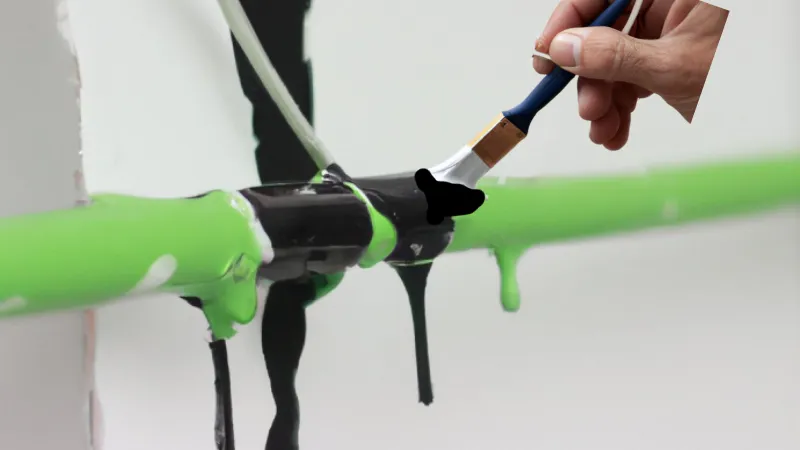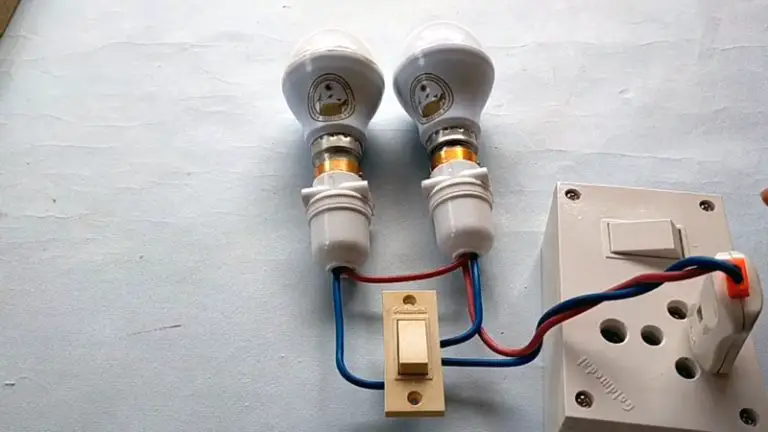Paint on Wire Insulation [Problems, Solutions, Tips]

Paint on electrical wire insulation can potentially cause problems with your electrical system and present a safety hazard. It is important to address any paint on wire insulation as soon as possible to prevent potential issues and ensure the safety of your electrical system.
If left unaddressed, paint on wire insulation could potentially cause flaking and accumulation of paint in connections, interfere with the proper functioning of the wires, or even cause a short circuit if the paint is on the copper wire itself.
It is important to carefully remove the paint and address any damaged wires to ensure the safe and proper functioning of your electrical system.
You Shouldn’t Paint on Wire Insulation
It is not recommended to leave paint on electrical wires, as it could potentially cause problems with the electrical system. While painting on the insulation of the wires may not cause immediate harm, it could potentially cause issues over time.
For example, the paint could flake off and get into the connections or the paint could interfere with the proper functioning of the wires. If the paint is on the copper wire itself, it could potentially cause a short circuit if it interferes with the connection.
If you have paint on your electrical wires, it is recommended to remove it as soon as possible. The best way to do this is to use a wire brush or a scraper to gently remove the paint. Be careful not to damage the insulation or the wire itself while removing the paint.
If you are unable to remove the paint or if you are unsure how to safely remove it, it is recommended to seek the assistance of a qualified electrician.
As for the damaged wire that you described, it is important to have it repaired or replaced as soon as possible. Exposed wires can be a serious safety hazard and can potentially cause electrical fires.
It is recommended to have a qualified electrician assess the damage and make the necessary repairs or replacements to ensure the safety of your electrical system. Do not attempt to make repairs yourself if you are not familiar with electrical work, as it can be dangerous.
Paint on Electrical Wires Can Be Harmful
- Insulation Damage: Paint can damage the insulation on electrical wires, making them more prone to electrical malfunctions and potentially hazardous.
- Reduced Conductivity: If paint is applied heavily enough, it can reduce the conductivity of the wire and cause it to overheat, potentially leading to a fire.
- Interference with Connections: Paint can interfere with connections between wires, leading to poor connections and a reduced ability to transfer electricity.
- Increased Resistance: Paint can increase the resistance of electrical wires, leading to increased heat generation and potential electrical malfunctions.
- Decreased Flexibility: Paint can make electrical wires less flexible, making them more prone to breakage and increasing the risk of electrical malfunctions.
- Difficulty in Inspection: If wires are coated in paint, it can be difficult to inspect them and identify any issues, increasing the risk of electrical malfunctions and failures.
- Safety Hazards: Paint on electrical wires can pose a safety hazard to people and animals, as it can cause electrical shock or even fire if it becomes damaged.
How Paint on Wire Insulation Can Cause Problems?
Paint on electrical wire insulation can potentially cause several problems with your electrical system.
Flake Off Over Time
One potential issue is that the paint may flake off over time and accumulate in connections, potentially causing a malfunction or even a short circuit.
Interfere With Wire Function
Another issue is that the paint may interfere with the proper functioning of the wires. If the paint is on the copper wire itself, it could potentially cause a short circuit if it interferes with the connection.
These potential problems highlight the importance of addressing paint on wire insulation as soon as possible to prevent any issues and ensure the safety of your electrical system.
Removing Paint From Wire Insulation
To remove paint from electrical wire insulation, it is recommended to use a wire brush or scraper to gently scrape off the paint. It is important to be cautious while removing the paint to avoid damaging the insulation or the wire itself.
If you are unsure how to safely remove the paint or if you are unable to remove it yourself, it is a good idea to seek the assistance of a qualified electrician. An electrician will have the tools and knowledge to safely remove the paint and ensure that the wire insulation is not damaged in the process.
It is important to address any paint on wire insulation as soon as possible to prevent potential issues and ensure the safety of your electrical system.
Repairing or Replacing Damaged Wire
If you have damaged electrical wire, it is important to address the issue as soon as possible for safety reasons. Exposed wire can be a serious hazard and can potentially cause electrical fires. It is recommended to have a qualified electrician assess the damage and determine the appropriate repair or replacement.
An electrician will have the knowledge and expertise to safely repair or replace the damaged wire and ensure the safety of your electrical system. It is important to not attempt DIY repairs if you are not familiar with electrical work, as it can be dangerous and potentially cause further damage.
It is always best to seek the assistance of a qualified electrician for any electrical repairs or replacements.
Tips to Resolve the Issue
Here are some additional tips for addressing paint on electrical wire insulation:
Use a Non-conductive Tool to Remove the Paint
To avoid the risk of electrical shock, it is important to use a non-conductive tool to remove the paint from the wire insulation. Plastic or wooden scrapers or brushes can be used for this purpose.
Protect the Surrounding Area
Before attempting to remove the paint, it is a good idea to protect the surrounding area with a drop cloth or other protective material. This will help to prevent paint splatters or drips from getting on other surfaces.
Use a Wire Stripper
If the paint is on the wire itself and the wire needs to be stripped, a wire stripper can be used to carefully remove the insulation without damaging the wire.
Wear Protective Gear
When working with electrical wires, it is important to wear protective gear to avoid accidental contact with live wires. This includes gloves, safety glasses, and closed-toe shoes.
Label Wires
If you need to remove the wires from their connections, it is a good idea to label them with tape or markers to ensure that you can easily reconnect them in the correct order.
Test the Circuit
After making any repairs or replacements, it is important to test the circuit to ensure that it is functioning properly. This can be done with a voltage tester or other electrical testing tool. If you are unsure how to test the circuit or if you encounter any issues, it is best to seek the assistance of a qualified electrician.
Choosing the Best Paint for Electrical Insulation
3M Scotch 1601 Electrical Insulating Spray
Pros: This clear spray paint is based on alkyd resin, which hardens into a flexible and resistant film that offers excellent adhesion to a variety of surfaces, including metal, glass, plastic, and wood. It is ideal for use as an insulating and covering material for electrical wiring and components.
Cons: 3M Scotch 1601 Electrical Insulating Spray may not be suitable for all types of electrical applications, as it is not heat-resistant and may not be able to withstand high temperatures in some electrical systems. Additionally, it may not be readily available in all regions and may be more expensive than other electrical insulation paints.
Silicone Rubber Coating
Pros: Silicone rubber is a versatile and durable material that is often used in electrical insulation applications. It offers excellent heat resistance, high flexibility, and strong adhesion to a variety of surfaces, making it ideal for protecting electrical components and wiring.
Cons: Silicone rubber coating can be difficult to apply and may require special equipment to apply it evenly and in a controlled manner. It may also be more expensive than other electrical insulation paints and may not be readily available in all regions.
Epoxy-based Paint
Pros: Epoxy-based paint is highly durable and provides excellent protection against moisture and other environmental elements. It offers strong adhesion to most surfaces and is often used in electrical insulation applications for its ability to provide a tight seal around electrical components and wiring.
Cons: Epoxy-based paint can be difficult to work with and may require specialized equipment for proper application. It may also be more expensive than other electrical insulation paints and may not be readily available in all regions.
Polyurethane-based Paint
Pros: Polyurethane-based paint is a highly flexible and durable material that offers excellent protection against moisture and environmental elements. It is often used in electrical insulation applications for its ability to provide a tight seal around electrical components and wiring.
Cons: Polyurethane-based paint can be more expensive than other electrical insulation paints and may not be readily available in all regions. It may also be difficult to apply, requiring specialized equipment and expertise to achieve proper coverage and protection.
The best paint for electrical insulation depends on a variety of factors, including the specific electrical application, environmental conditions, and budget constraints.
3M Scotch 1601 Electrical Insulating Spray, Silicone Rubber Coating, Epoxy-based Paint, and Polyurethane-based Paint are all viable options for electrical insulation, each with its own unique pros and cons.
It is important to carefully consider all factors when choosing the best paint for electrical insulation to ensure optimal performance and protection.
Also Read – Are Duraflame Logs Safe To Breath?
Conclusion
In conclusion, paint on electrical wire insulation can potentially cause problems with your electrical system and present a safety hazard. It is important to address any paint on wire insulation as soon as possible to prevent potential issues and ensure the safety of your electrical system.
If you have a damaged wire, it is important to have it repaired or replaced by a qualified electrician to ensure the safety of your electrical system. Remember to be cautious while removing paint from wire insulation and to seek professional assistance if necessary.
Ensuring the safety of your electrical system is crucial, and addressing paint on wire insulation is an important step in maintaining a safe and functional electrical system.

